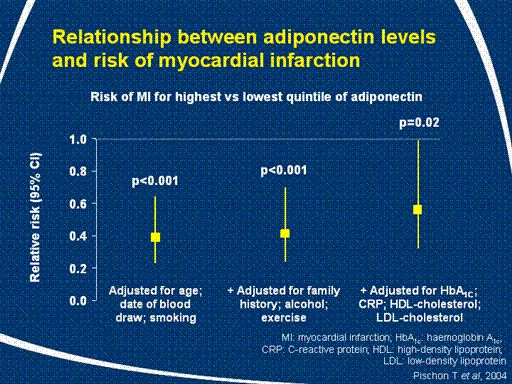| front |1 |2 |3 |4 |5 |6 |7 |8 |9 |10 |11 |12 |13 |14 |15 |16 |17 |18 |19 |20 |21 |22 |23 |24 |25 |26 |27 |28 |29 |30 |31 |32 |33 |34 |35 |36 |review |
 |
The relationships between plasma adiponectin levels and the risk of
myocardial infarction were
evaluated in a case-control study involving 18,225 male participants of
the Health Professionals
Follow-up Study, aged 40–75 years and free of cardiovascular disease at
baseline.
During 6 years of follow-up in the main cohort, 266 men developed fatal
or non-fatal MI. Control
subjects, matched for
age, date of blood
draw, and smoking status,
were selected in a 2:1 ratio
(n=532).
Subjects were stratified into quintiles of adiponectin.
Mean adiponectin levels (mg/L) in each quintile (Q1–Q5) were: Q1: 7.9;
Q2: 12.6; Q3: 16.5; Q4: 21.1; Q5: 29.2.
Low adiponectin levels were associated with a higher risk of MI. This increased risk remained
significant after adjustment for variables used in matching cases to
controls, after further
adjustment for
family history of
MI, BMI, alcohol use, physical activity, and history of diabetes or
hypertension, and after additional adjustment for glycaemic status,
C-reactive protein and lipid parameters (LDL-cholesterol and HDL-cholesterol
|